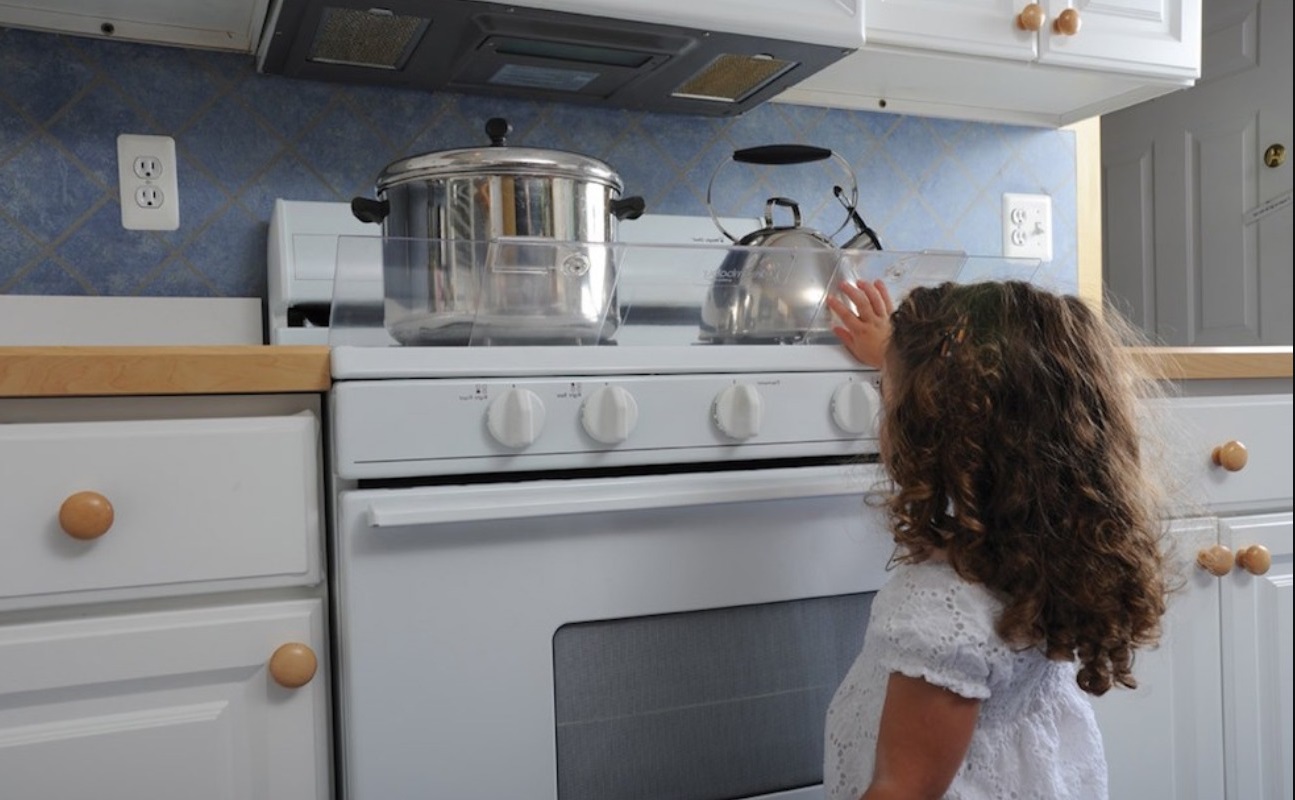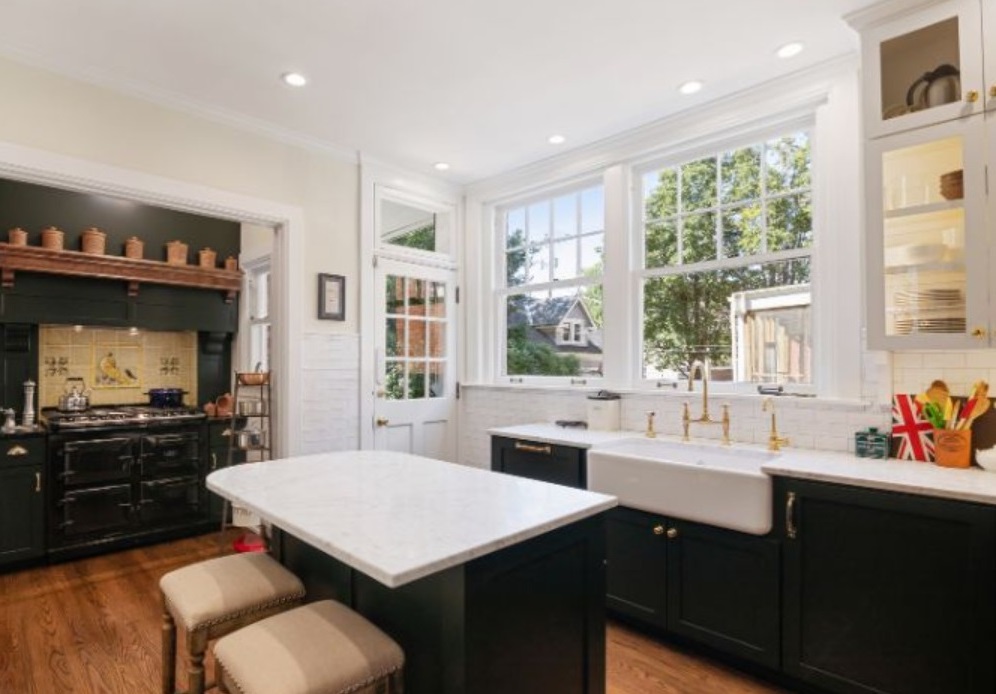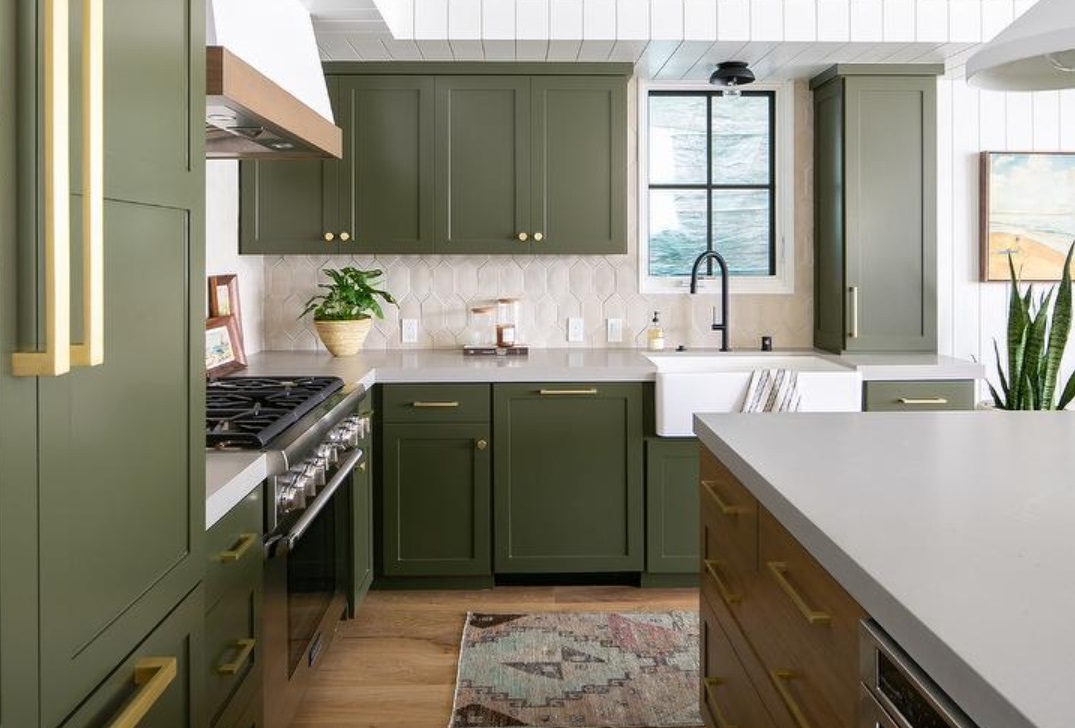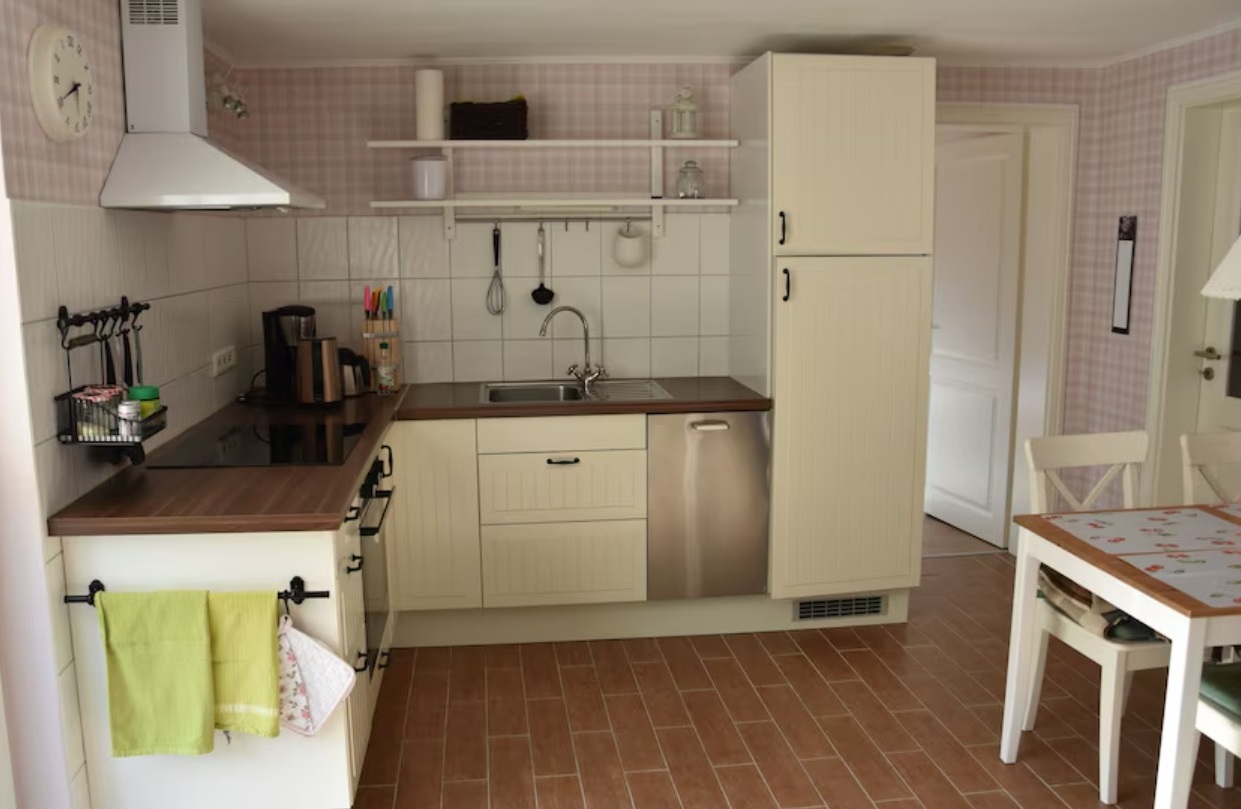The kitchen is an intriguing place for children, as there are many interesting things to observe and experience. Of course, children also want to be involved and try things out for themselves. What is stored in the cupboards and drawers? What can you do with these appliances and ingredients? But it’s important to be cautious, as there are numerous potential dangers for children in the kitchen. By following our tips, you can enjoy family time in the kitchen without having to miss out on the assistance and curiosity of the little ones.
Little kitchen helpers are a big deal
Baking, cooking, and mixing ingredients are activities that children enjoy when their parents involve them as kitchen helpers. Cooking together is not only enjoyable; children also learn about food and its proper use.
If there is enough space in the kitchen, you can also set up a play kitchen or install a practical blackboard. This will allow the little ones to be right in the middle of the action and be well looked after during more lively moments. A U-shaped open kitchen or a kitchen with a cooking island are perfect for this. Comfortable seating that complements the kitchen can be seamlessly incorporated. Draw inspiration from our kitchens designed for the entire family.
Child-safe kitchen appliances and accessories
You can make your kitchen child-safe and protect your little ones from harm with the right appliances. Many built-in appliances are equipped with child-safe features, making them ideal for family kitchens. For instance, AEG offers ovens with “touch-safe” outer doors. In these ovens, the temperature of the outer oven door remains low, allowing it to be safely touched. Induction hobs also provide added safety, as they only generate heat when a pan is placed on the hob. This means that there is no hot stove surface after cooking, which could potentially burn children.
Additionally, there are practical kitchen accessories that ensure safety, such as child safety gates for hobs and locks for doors and drawers. Children are often drawn to boiling water and hot steam, and their little hands may reach for hot pans. The protective grid on the hob prevents your child from touching hot pots or pans.
Of course, knives, scissors, and other sharp kitchen utensils should not be handled by children without supervision. Fortunately, drawers and cupboard doors are easily secured, including finger pinch protection. Drawer locks are either integrated into the drawers or can be added later, ensuring that sharp objects or hazardous liquids are out of reach of children’s hands.

10 suggestions for a child-friendly kitchen
While no kitchen can be completely child-proof, our 10 tips can help you minimize most of the risks.
- Supplied space under supervision: As a general rule, small children should never be left unattended in the kitchen. If your child wants to assist in the kitchen, provide them with a safe, designated area. This gives the child the sense of having their own space where they can pretend to be a little chef with wooden spoons, pots, and plastic bowls.
- Fun and informative explanations: Repeatedly explain to your child in an engaging manner what the dangers are in the kitchen.
- The kitchen is not a play area for children: Falls are the most common cause of accidents in homes. There is a risk of slipping, particularly on slippery floors splashed with oil or water. Therefore, do not allow your child to run around in the kitchen. Some kitchen furniture might be tempting for climbing. The kitchen table and stove are often used as climbing aids to reach the wall cupboards. Always keep the stools and ladders you use out of your child’s reach after use. This will make their climbing attempts more difficult.
- Safety gear for the kitchen: Protective grids on the hob prevent pots from falling and prevent young children from touching hot surfaces. A cover plate for the oven window is also important if it is installed at a height that is out of reach of children. Additionally, secure drawers and doors with safety locks to prevent children from accessing cleaning supplies, knives, or other dangerous kitchen tools. All electrical outlets should also be fitted with child safety locks.
- Protection from electrical devices: Keep electrical devices such as kettles, blenders, or coffee machines out of reach of children. Ensure that cables are not hanging down. Be cautious when using electrical devices near water. It is advisable to unplug them after use and store them.
- Cook cautiously: When cooking, place pots and pans at the back of the stove whenever possible. If they are filled, always turn them upside down.
- At a height safe for children: Always keep the oven and dishwasher closed. If you are planning a new kitchen, it is best to position the oven at a convenient height, out of a child’s reach. This way, children will not be able to reach them.
- To prevent accidents, cover sharp edges on cupboards and tables with edge/corner protectors, such as those made of silicone.
- When setting the table, make sure to place pots and bowls containing hot food in the middle of the table. Avoid using a tablecloth as children may try to hold onto it and accidentally pull everything down if they shake the table.
- Keep hazardous items out of children’s reach by storing them in a lockable or secure location:
– Dishwashing and cleaning products
– Matches
– Spices
– Alcoholic beverages
– Medications
– Small objects that could be swallowed
– Plastic bags
– Sharp knives and other dangerous cutlery
– Fruit bowls containing cherries or nuts as they pose a suffocation hazard.

Creative recipes for kids
Small children are easily impressed – our quick recipes are sure to delight. After all, presentation is key. With a little creativity, any mundane ingredient can be transformed into an imaginative dish.
Spaghetti Sausage Spiders:
Ingredients for 4 servings:
300 grams of spaghetti
6 sausages
broth
Tomato sauce or ketchup, to taste
First, cut the sausages into finger-sized pieces. Carefully thread 4 pieces of spaghetti into each sausage slice. Bring the broth to a boil in a large pot and cook the spaghetti sausages until the pasta is al dente (approximately 10 minutes). Then drain the water and plate the spaghetti spiders.
For those with some extra patience, you can add two drops of tomato sauce to each sausage piece, giving the spaghetti sausage spiders their eyes.
Colorful Pancakes:
With a bit of pancake batter, fresh strawberries, and blueberries, you can quickly create charming, colorful faces. For the pancake batter, mix flour, eggs, sugar, a pinch of salt, and milk, then cook in a pan.
Tomato Mozzarella Caterpillars:
Small cocktail tomatoes transform into adorable caterpillars with a few mini mozzarella balls and balsamic cream.
Family kitchen: The heart of the home
This is where you can craft, play, study, chat, work – and cook. Family kitchens are ideal for family meals, tea parties, game nights, and kids’ birthday parties. They can double as a home office, craft room, or a place to gather during difficult times. That’s why architects often make open kitchens the central hub of apartments or houses, designed to accommodate young families. Here’s what makes a family kitchen and how to create one.
Get the kids involved in cooking
Regardless of the kitchen’s layout – whether it’s an L or U shape, an island configuration, or a classic kitchen unit – the most important aspect of a family kitchen is bringing everyone together, fostering communication and maintaining eye contact. The table serves not only as a dining area but also allows children to help with food preparation. With a step stool, your little one can assist with stirring pots and pans under supervision, as there is a risk of burns. After use, the stool can be easily stored under the dining table to keep it out of the way.
Advantages of a closed kitchen
The closed kitchen offers its own benefits as well. This design is often a good fit for older apartments. Its motto is “Shut the door, hide the mess”. Sliding doors are especially useful when you want to postpone dishwashing for a while. Additionally, they take up less space than standard doors, which is important in a family kitchen. When children want to help chop vegetables, this activity can move to the dining table in the living room. An open kitchen with a dining area is not necessary.
By the way, children enjoy using a hatch, a design element that should be considered, particularly during renovations, to connect the kitchen and living room. This configuration is especially practical when the surrounding cupboards are easily accessible from both the kitchen and the dining room.

Ample storage space is essential
As the family grows, kitchen space can quickly become limited. It’s important to store children’s dishes, baby bottles, and other items properly. Consider this when planning the kitchen, as subsequent renovations tend to be costlier. A typical family of four must accommodate 250 kilograms of kitchen equipment, so ample storage space is a must.
- The kitchen island offers ample storage space and is perfect for a family kitchen due to its increased pull-out depth of 60 centimeters, allowing it to accommodate more utensils than standard kitchen units.
- It’s advisable to include plenty of pull-outs, preferably with full extensions, as they are more convenient than regular shelves and allow for easy access to items at the back.
- Optimize the use of corners in U-, G-, or L-shaped kitchens by incorporating carousels or MagicCorners to maximize storage space.
- The pharmacy cabinet is ideal for storing everyday ingredients like cornflakes and oatmeal in a family kitchen, allowing for easy access from both sides.
Safety Measures
Kitchens can pose potential dangers for children due to hot stoves, sharp corners, and knives. Therefore, safety is prioritized when designing a family kitchen. Various safety features enable children to participate in kitchen activities without hesitation. Induction hobs are recommended for their safety, as only the pan, and not the hob, heats up, minimizing the risk of burns. However, children should not be left unsupervised while using the hob. Additionally, lockable screens are available to prevent children from operating appliances such as the hob, oven, or dishwasher with their curious fingers.
To prevent children from accessing cleaning supplies and other potentially harmful items, cupboards and drawers can be secured with a key or internal locks that don’t affect the exterior appearance of the kitchen.
Criteria for Selecting a Family Kitchen:
Children’s safety and mobility in the kitchen are prioritized, with considerations for selectively securing sockets or cupboards to accommodate specific phases and then removing the safety measures as needed.
When renovating or constructing a new home, early inclusion of kitchen planning in discussions with the architect is cost-effective and efficient.
Consider whether you can tolerate children’s fingerprints on surfaces for an extended period, especially with handleless and glossy fronts.
When choosing the material for kitchen fronts, consider that glass or painted surfaces may be prone to scratches from toys like bobby cars. Sturdy laminate fronts are a better option without compromising on design.
Families require ample storage space not only for food but also for large pots and bowls. Well-planned kitchen storage optimizes space for accommodating all utensils without overcrowding the cupboards.
The kitchen serves as a communication center, and kitchen manufacturers offer various features to support communication, such as magnetic extractor hoods and writable refrigerators.
The kitchen should cater to child-friendly needs while offering comfort and luxury for adults in the future. Features like a dishwasher at worktop height protect children and adults’ backs, while an extra-large fridge ensures freshness and organization regardless of life stage.
Waste management is essential in family kitchens, and internal waste separation systems teach even the youngest children about environmentally friendly waste sorting. However, it’s crucial to equip the kitchen with child safety locks on waste containers to prevent little explorers from dispersing waste around the kitchen.
Including a table in the kitchen not only creates a dining area but also allows young children to engage in kitchen activities. It also enables closer supervision of children while they do homework or play, while adults can prepare meals.
Appliance Sizing for Family Needs
Refrigerators, dishwasher technology, and cooking/baking options should be tailored to accommodate the family’s needs, emphasizing “generous” planning for kitchen storage to accommodate not only food but also a significant amount of plates, utensils, and equipment.
Fridge: Family Nutrition Centrepiece
For fresh food, a spacious refrigerator is necessary. A family of two adults and two children requires over 200 liters of refrigerator space to have up to three nutritious meals daily. Allow 80 liters of refrigerator space per person. Given the large size and 24/7 operation of a refrigerator, it’s advisable to opt for an energy-efficient model. A good energy efficiency class enables economical cooling, resulting in immediate savings on additional costs. A better energy class translates to approximately 25 percent less electricity consumption.
The interior of the family refrigerator should offer ample space for various fresh foods like fruits, vegetables, meat, fish, and dairy products. The zero-degree area and drawers are perfect for storing items in the refrigerator. Fresh food stays flavorful and crisp up to three times longer in this particular cooling zone compared to a conventional cooling area. Considering that no door in the kitchen is opened more frequently than the refrigerator door, easy accessibility of refrigerator contents is essential. Especially for families, it’s best not to position the refrigerator too high for easy access, including for children.

Smart Freezing: Efficient Food Storage
Food often runs out faster than anticipated even with careful planning. Freezing food is an effective solution. A fridge-freezer combination with a separate freezer under the refrigerator works well. Chest freezers are suitable for freezing meat, vegetables, fish, or pre-cooked food. They don’t have to be in the kitchen; a pantry or basement is also suitable. The volume guidelines are similar to refrigerator volume: a freezer capacity of 50 to 80 liters per person is quite convenient. Choosing an energy-efficient freezer is strongly recommended.
Refrigeration Technology Checklist for Families
80 liters of refrigerator space per family member
Include a zero-degree area or drawer with sufficient dimensions
Choose an energy-efficient appliance
Ensure easy accessibility when setting up/placing the refrigerator
Plan for a freezer capacity of at least 50 liters per person
The freezer does not have to be in the kitchen; the pantry or basement is suitable.
Dishwasher: Ultimate Cleanup Solution
When setting up a family kitchen, opt for a larger dishwasher—appliances with a width of 60 centimeters are essential. Simply load the everyday dishes—four plates, glasses, and cutlery for breakfast, lunch, and dinner—and appreciate having them out of sight. On average, the family dishwasher runs at least once a day, handling plates, pots, pans, lunch boxes, and coffee cups.
Since the dishwasher is used daily, it’s best to choose an appliance with a very good efficiency class. Consider the machine’s flexible interior layout, as not every washing cycle includes pots and pans. Seeking professional advice, including volume, is crucial. A noise level of less than 50 dB is preferable, allowing for comfortable conversations in the kitchen while the dishwasher is running. A quiet dishwasher is also essential for an open kitchen.
Like other kitchen electrical appliances, you can integrate the dishwasher into a kitchen cupboard at a suitable height for easier packing and unpacking. However, this involves the safety of small children. If top installation is not feasible, consider a machine with a mechanism that raises the lower basket to the height of the upper basket.
Dishwasher Checklist for Families
A width of 60 centimeters is necessary
Ensure the dishwasher basket is flexibly mounted
Choose a noise class below 50 dB
A high efficiency class is recommended
When placing it, consider whether children are allowed to access the dishwasher.
Cooking Area: Optimal for Families
Cooking has evolved: High flexibility and fast speeds are key in family recipes. Food intolerances and individual preferences pose different cooking requirements. This often leads to the preparation of separate dishes. For instance, a spicy chili con carne for adults and a mild version for children. Hence, your cooking area should have enough hobs to prepare various dishes simultaneously. Six cooking zones are ideal for handling all situations.
If it’s possible, opt for induction technology. It has several benefits: from an energy perspective, heat is only generated where the pots are located, eliminating the need for a glowing hob. Induction technology heats the bottom of the cookware precisely, while the rest of the glass ceramic surface remains cool. This results in another advantage: children will be less likely to get burned if they touch the hob out of curiosity. Additionally, induction offers flexible zones or full-surface hobs, providing a wide range of options. When equipping a family kitchen, it’s advisable to choose a lockable control panel to prevent children from tampering with it.
Ensure you have enough cooking hobs – six is considered ideal. For safety reasons, opt for induction technology. Take into account the device’s efficiency rating. A control panel with a lock function enhances safety.
Oven – ideal for traditional family meals. When selecting an oven, go for an extra-large one if you are setting up a family kitchen. Standard ovens are typically 60 centimeters wide and tall. It’s best to avoid smaller models as they may not accommodate larger meals such as a Sunday roast or Christmas goose. Alternatively, consider a 90-centimeter wide oven for added comfort. In terms of safety, consider ovens with cool outer panels, especially for families with children. The oven’s positioning is crucial for a well-planned family kitchen. Mount the oven at an optimal working height, around 20 centimeters above the worktop. For added safety, if the oven is installed under the hob, consider a pull-out mechanism to remove hot dishes, reducing the risk of burns.
For a healthier diet, consider an oven with a steam cooking function, or better yet, a separate steamer. These options allow for quicker and simultaneous cooking without transferring flavors. Additionally, a self-cleaning oven program is recommended due to frequent use in a family kitchen.
When it comes to cooling technology, dishwashers, hobs, and ovens, ensure they have enough capacity to handle daily use. Safety is also crucial in a family kitchen. Appliances that are child-friendly and safe, even when unsupervised, are highly recommended. Properly equipping the family kitchen will help organize daily life and create more time for other important tasks.
Take advantage of the experiences of others when planning a family kitchen. Ask friends and family about their kitchen needs and experiences. Every family is different, but many share similar requirements for comfort, design, safety, and functionality. The kitchen becomes unique through its residents, and the right solutions and planning information can be found in a kitchen studio.
While the young ones may no longer need colorful step stools and sturdy high chairs, and the days of navigating Lego bricks and knight castles are over, most families still have the trusty indestructible plastic bowls and jars in the bottom drawer, although they are no longer as prominently used as before.

Increased storage and reduced clutter: 9 ingenious concepts for a family-oriented kitchen
A kitchen is as flexible as the individuals who utilize it, but they all share a common element: practicality! We illustrate 9 kitchens designed for families that go beyond just cooking!
Not all families are alike, and as a result, their kitchens differ as well! However, many family kitchens are regarded as the “hub” because they serve as the main gathering place where people congregate to not only prepare and cook meals, but also to converse, play, and work. Another common feature in multi-generational kitchens is the need for ample storage space. Naturally, the more people there are, the more pots, pans, and lunch boxes are required. To ensure that the kitchen remains uncluttered amidst the daily hustle and bustle, all of these items should be neatly stored in cabinets equipped with practical pull-out compartments. This allows for easy access and maximizes the use of the entire cabinet depth.
Additional islands are a popular addition to family kitchens. They not only provide extra storage in the form of more drawers, but also expand the workspace and usually include seating for a small dining area or work station. On the other hand, if household chores are carried out at the adjacent dining table, the kitchen should have an open layout, enabling you to keep an eye on the little ones while cooking.
A space for the entire family! These 9 family kitchens bring together both young and old.
#1 The open kitchen as the focal point and social center of the home
With three generations living under one roof, it’s not uncommon for homes designed for multigenerational living. In addition to the three-member family, grandparents also frequently visit. To ensure that everyone has their own space, several partitions were removed during the remodeling process, creating a spacious living and dining area that also incorporates an open kitchen. To visually connect the areas, the table, as well as the kitchen and island units, are crafted from the same dark walnut wood, which boasts an elegant and eye-catching grain and contrasts beautifully with the light oak flooring. One of the most practical and notable features of the family kitchen is the floor-to-ceiling cupboards, which offer ample storage space and conceal small and large electrical appliances such as the refrigerator and even two freezers.
#2 A fun kitchen loved by parents, children, and even cats
Whether it’s mom, dad, or the kids, since all the inhabitants of this bright house enjoy spending time in the kitchen, it’s less like a cooking space and more like a comfortable living area. This is reflected in the choice of a round table at the end of the kitchen island and a separate small shelf on the wall. Unconventional colors are also part of the inspiration, with bright pink being prominently featured in the shelves and a unique three-armed ceiling lamp. Colorful retro-style kitchenware and abundant tall green plants add even more splashes of color, creating a cozy ambiance that has even become the favorite spot of the family cat. While the hygiene aspect may be debatable, the cozy atmosphere is completely understandable!
#3 A stylish, family-friendly kitchen with a timeless appeal, thanks to light earthy tones
At first glance, it’s evident that this kitchen thrives on a warm, bright, and perfectly coordinated color palette, while also excelling in terms of functionality and family friendliness. The curved surfaces cleverly and discreetly eliminate the need for handles on the cabinet doors, making them easy to open. Additionally, the seamless transition from the countertop to the backsplash removes hard-to-clean gaps. Ample space is created by placing two semicircles adjacent to each other, allowing the spacious gray and beige kitchen island to be utilized as both a workspace and a dining or work area for the entire family, offering plenty of legroom for the little ones.

#4 In grey London, this pink kitchen adds a pop of color.
Thanks to a complete redesign by the Unknown Works team, this once dark Victorian townhouse in north London was in need of renovation. Now, it boasts a soft rose color and offers its occupants a cheerful and pleasant retreat, even on dreary days. The heart of the 260-square-meter house is the kitchen and living room, which have been seamlessly combined and now span the entire ground floor. The kitchenette and island were specially made in oak by request of a family friend and provide ample storage space for all the kitchen tools and equipment for a neat look, including a small seating area for relaxed breakfasts. Family dinners are typically enjoyed at the large dining table, which not only offers a view of the sloping garden but also provides a clear view of the sky through its glass roof due to its position. Moreover, on days with fine London weather, the room can be easily opened using large sliding doors, allowing the group to move to the renovated terrace and garden.
#5 Smart cooking: A favorite gathering spot for all.
The remodel of this kitchen in the San Francisco Bay Area to accommodate three generations was a smooth process. The family of four frequently hosts visits from their grandparents, requiring accessibility to be ensured. The initial step involved raising the lower living room and removing the wall to the kitchen. Now, only a large island separates the kitchen from the living and dining areas. A small writing and work area was also established in one corner to meet the needs of the two daughters, who enjoy doing their homework there. The owners chose the colors themselves with the interior designer, opting for white and steel gray, which bring freshness and brightness to the dark walnut wood and the rest of the kitchen.

#6 Kitchen that maximizes storage space with an element of fun.
This clever green kitchen made of powder-coated steel demonstrates how to create ample storage space in a compact area. To utilize the space between the door and the window without obstructing the entry of light, four cabinets of the appropriate size were installed, reaching up to the ceiling. Additionally, to ensure that all ingredients are easily accessible for both adults and children in the family kitchen, stainless steel manufacturer MWE produced a ladder in matching colors that can be swiftly and effortlessly hung in the right place with hooks, transforming cooking into a fun climbing game for the entire family!

#7 Love it all! A minimalist kitchen can feel very inviting.
A minimalist design does not entail sacrificing functionality and practicality for daily use. If you desire a timeless look that resembles a piece of furniture rather than a kitchen, opt for the same matte material for the fronts and worktops. Conceal the visible electrical appliances and even the small kitchen appliances in the spacious apothecary cabinet. Additionally, there are no handles, hooks, or exposed cooking utensils in this very small and enclosed kitchen. Consequently, when combined with the architectural details of the old apartment, such as herringbone parquet, large arches, eye-catching lamps, and fluffy Japanese maples, an elegantly balanced image is created.
#8 The oak kitchen boasts more than just ample storage space.
If you appreciate contemporary ceramics and seek natural and eco-friendly materials in earthy colors for your home redesign, consider Japanese Yakisugi wood for the entrance area, sand-colored onyx marble for the island and kitchen table, and light oak for the ceiling-high cupboards where small kitchen appliances and other equipment can be stored. To maintain the useful appearance of treasures and ceramic collections, only glass fronts are installed on the upper cupboards, and the small shelves on the island are completely made without fronts.
#9 Semi-open family kitchen with cheerful and fresh details.
The family kitchen on the ground floor is designed to be bright and airy, which is why the base – cupboards, walls, and floor – remains white and is accented with yellow and orange. Adequate storage space was created with floor-to-ceiling cupboards and an additional island, with Eden providing attractive custom-made terrazzo slabs and a three-dimensional cladding made of semi-circular oak logs to bring the space to the foreground. To ensure easy accessibility, the island and the corner cupboard opposite it are rounded on the sides.
